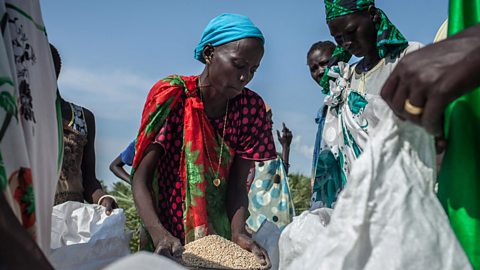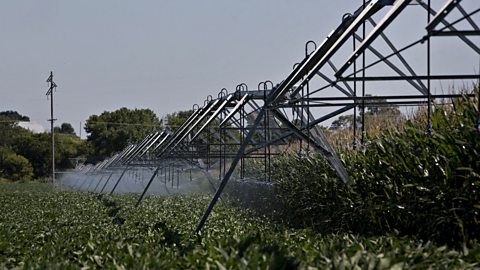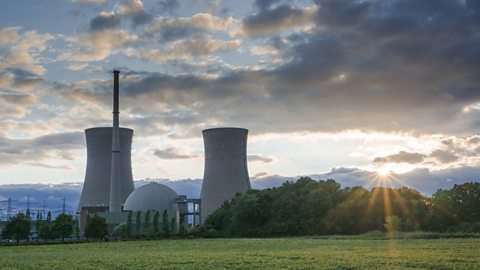Resources - food, energy and water
resourceA supply of something (eg money or materials) that can be used. are a supply of something (eg money or materials) that people use. Some resources are essential for survival, whilst others are needed to maintain a standard of livingThe amount of wealth or personal comfort that a person or group of people have..
Food
People cannot live without food. An average person needs to consume between 2,000 and 2,500 caloriesThe units of energy contained in food and drink. per day. The actual number of calories needed depends on factors such as gender, age, height and level of activity.
Eating too few calories causes weight loss and a lack of energy. People who do not have enough food to eat find it difficult to work. If there are too many people in a country who are unable to work, then that country will lose a lot of money. Regularly consuming more calories than are burned causes weight gain. People who eat too many calories for a sustained period of time can also find it difficult to work.

Water

People cannot live without clean, safe drinking water. Water makes up about two thirds of a person's body. It is needed for the body to function, eg to absorb nutrients and get rid of waste. Each person should drink a minimum of 1.6 to 2 litres of water a day. The actual amount of water needed depends on factors such as the air temperature and the type of activity that a person undertakes each day.
Water is also used to keep people clean and healthy and is needed to grow food and for industryThe type of work that people do.. In drier countries or drier seasons, irrigationThe channelling of water from rivers and streams to fields in order to help crops grow. enables crops to grow. Industry uses water in many ways, such as cleaning, cooling and as a raw materialBasic material that goods are made from such as crops, metals, wood and animal products such as wool and leather. in production.
Exploring the issues linked to distribution and access to water in different parts of the world
Energy

energyThe capacity of a system to do work or the quantity required for mechanical work to take place. Measured in joules (J). For example, a man transfers 100 J of energy when moving a wheelbarrow. has many uses. It heats homes and offices, cooks food and powers transport. Much of the energy that used is in the form of electricity. This is called secondary energyEnergy that has been converted into a more useful form, eg electricity. - primary energyEnergy in its raw, unchanged state, eg oil and wind power. sources, such as fossil fuelNatural, finite fuel formed from the remains of living organisms, eg oil, coal and natural gas. or the wind, have been used as a fuel to generate it.
Energy affects both food supplies and industry. miningWhen natural resources are extracted from the ground. and growing biofuelA type of energy source derived from renewable plant and animal materials, eg ethanol (often made from corn in the United States and sugarcane in Brazil), biodiesel (vegetable oils and liquid animal fats) and biogas (methane from animal manure). required to generate energy takes up valuable farmland, which reduces the amount of food available to eat. And if energy is more expensive or in short supply, then it costs more to produce and transport food. This is therefore passed on to consumers through an increase in the price of food.